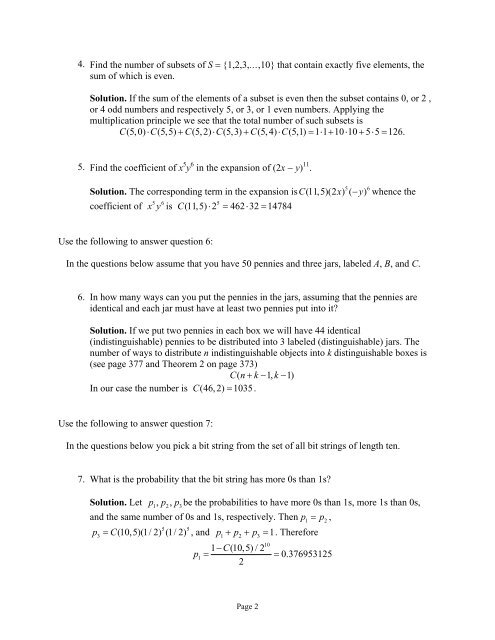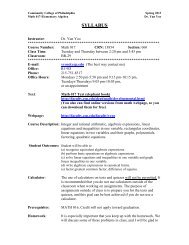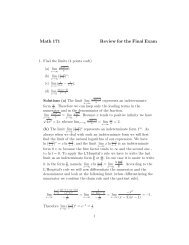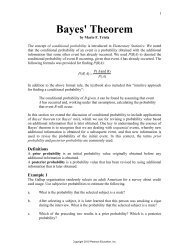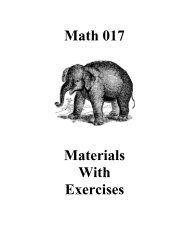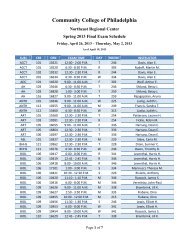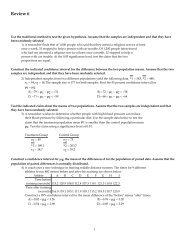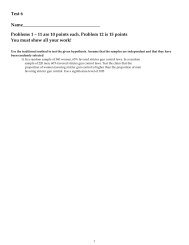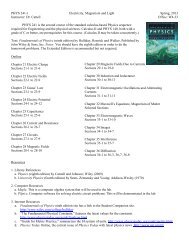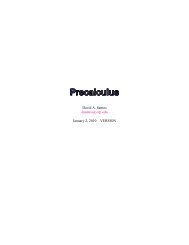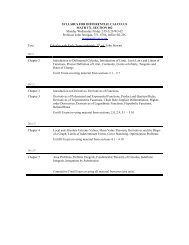163 Discrete Mathematics Review 2 Use the following to answer ...
163 Discrete Mathematics Review 2 Use the following to answer ...
163 Discrete Mathematics Review 2 Use the following to answer ...
Create successful ePaper yourself
Turn your PDF publications into a flip-book with our unique Google optimized e-Paper software.
4. Find <strong>the</strong> number of subsets of S = {1,2,3,…,10} that contain exactly five elements, <strong>the</strong><br />
sum of which is even.<br />
Solution. If <strong>the</strong> sum of <strong>the</strong> elements of a subset is even <strong>the</strong>n <strong>the</strong> subset contains 0, or 2 ,<br />
or 4 odd numbers and respectively 5, or 3, or 1 even numbers. Applying <strong>the</strong><br />
multiplication principle we see that <strong>the</strong> <strong>to</strong>tal number of such subsets is<br />
C(5,0) ⋅ C(5,5) + C(5, 2) ⋅ C(5,3) + C(5, 4) ⋅ C(5,1) = 1⋅ 1+ 10⋅ 10 + 5⋅ 5 = 126.<br />
5. Find <strong>the</strong> coefficient of x 5 y 6 in <strong>the</strong> expansion of (2x − y) 11 .<br />
5<br />
Solution. The corresponding term in <strong>the</strong> expansion isC(11, 5)(2 x) ( −y)<br />
6 whence <strong>the</strong><br />
5 6<br />
5<br />
coefficient of x y is C(11,5) ⋅ 2 = 462⋅ 32 = 14784<br />
<strong>Use</strong> <strong>the</strong> <strong>following</strong> <strong>to</strong> <strong>answer</strong> question 6:<br />
In <strong>the</strong> questions below assume that you have 50 pennies and three jars, labeled A, B, and C.<br />
6. In how many ways can you put <strong>the</strong> pennies in <strong>the</strong> jars, assuming that <strong>the</strong> pennies are<br />
identical and each jar must have at least two pennies put in<strong>to</strong> it<br />
Solution. If we put two pennies in each box we will have 44 identical<br />
(indistinguishable) pennies <strong>to</strong> be distributed in<strong>to</strong> 3 labeled (distinguishable) jars. The<br />
number of ways <strong>to</strong> distribute n indistinguishable objects in<strong>to</strong> k distinguishable boxes is<br />
(see page 377 and Theorem 2 on page 373)<br />
Cn ( + k−1,<br />
k−<br />
1)<br />
In our case <strong>the</strong> number is C (46,2) = 1035.<br />
<strong>Use</strong> <strong>the</strong> <strong>following</strong> <strong>to</strong> <strong>answer</strong> question 7:<br />
In <strong>the</strong> questions below you pick a bit string from <strong>the</strong> set of all bit strings of length ten.<br />
7. What is <strong>the</strong> probability that <strong>the</strong> bit string has more 0s than 1s<br />
Solution. Let p1, p2,<br />
p3be <strong>the</strong> probabilities <strong>to</strong> have more 0s than 1s, more 1s than 0s,<br />
and <strong>the</strong> same number of 0s and 1s, respectively. Then p 1<br />
= p 2<br />
,<br />
5<br />
p3 = C(10,5)(1/ 2) (1/ 2) 5 , and p1+ p2 + p3 = 1. Therefore<br />
10<br />
1 − C(10,5)/2<br />
p1<br />
= = 0.376953125<br />
2<br />
Page 2


